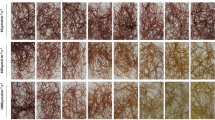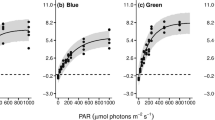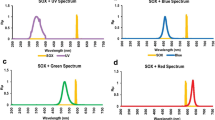Abstract
Although known, the photosynthetically active radiation (PAR) triggers responses that still deserve attention. Then, our study aims to investigate the photoresilience responses of Gracilariopsis tenuifrons (C.J. Bird and E.C. Oliveira) Fredericq and Hommersand and the metabolic changes related with NO levels to understand the connective physiological responses under high light exposure. This outcome was evaluated after exposing this red alga for a week, to PAR levels of 60 and 600 μmol photons m−2 s−1, in both day and night phases. Growth rate, CHN (carbon, hydrogen, and nitrogen) contents, photosynthetic pigments (phycoerythrin, phycocyanin, chlorophyll-a, and carotenoids), total soluble proteins (TSP), antioxidant capacity, and nitric oxide (NO) production were analyzed. High PAR promoted the dissociation and diminution of photosynthetic pigments, thickened cell walls, increased C and H levels and antioxidant activity, raised NO values, and attenuation of N levels. Phycobiliproteins together with nitrogen and carbon metabolisms, antioxidant activity, and remarkable NO action have played significant roles in the photoresilience, as well as light-stress responses in G. tenuifrons under high PAR.








Similar content being viewed by others
References
Abdala-Diaz RT, Cabello-Pasini A, Perez-Rodriguez E, Conde Alvarez RM, Figueroa FL (2006) Daily and seasonal variations of optimum quantum yield and phenolic compounds in Cystoseira tamariscifolia (Phaeophyta). Mar Biol 148:459–465
An L, Liu Y, Zhang M, Chen T, Wang X (2005) Effects of nitric oxide on growth of maize seedlings leaves in presence of ultraviolet-B radiation. J Plant Physiol 162:317–326
Arnold TM, Tanner CE, Hatch WI (1995) Phenotypic variation in polyphenolic content of the tropical brown alga Lobophora variegata as a function of nitrogen availability. Mar Ecol Prog Ser 123:177–183
Balskus EP, Walsh CT (2010) The genetic and molecular basis for sunscreen biosynthesis in cyanobacteria. Sci 329:1653–1656
Banskota AH, Stefanova R, Sperker S, Lall S, Craigie JS, Hafting JT (2014) Lipids isolated from the cultivated red alga Chondrus crispus inhibit nitric oxide production. J Appl Phycol 26:1565–1571
Baroli I, Do AD, Yamane T, Niyogi KK (2003) Zeaxanthin accumulation in the absence of a functional xanthophyll cycle protects Chlamydomonas reinhardtii from photooxidative stress. Plant Cell 15:992–1008
Beer S, Eshel A (1985) Determining phycoerythrin and phycocyanin concentration in aqueous crude extracts of red algae. Aust J Mar Freshw Res 36:785–792
Beligni MV, Lamatina L (1999) NO protects against cellular damage produced by methilviologes hebicides in potato plants. Nitric Oxide 3:199–208
Bhattacharya A, Sood P, Citovsky V (2010) The roles of plant phenolics in defence and communication during Agrobacterium and Rhizobium infection. Mol Plant Pathol 11:705–719
Bird CJ, Oliveira EC (1986) Gracilaria tenuifrons sp. nov. (Gigartinales, Rhodophyta), a species from the tropical western Atlantic with superficial spermatangia. Phycol 25:313–320
Blois MS (1958) Antioxidant determinations by the use of a stable free radical. Nature 181:1199–1200
Blokhina O, Fagerstedt KV (2010) Reactive oxygen species and nitric oxide in plant mitochondria: origin and redundant regulatory systems. Physiol Plant 138:447–462
Bondet V, Brand-Williams W, Berset C (1997) Kinetics and mechanisms of antioxidant activity using the DPPH free radical method. LWT 30:609–615
Bradford M (1976) A rapid method for the quantification of microgram quantities of protein utilizing the principle of protein-dye binding. Anal Biochem 72:248–254
Brand-Williams W, Cuvelier ME, Berset C (1995) Use of a free radical method to evaluate antioxidant activity. LWT 28:25–30
Cheynier V, Comte G, Davies KM, Lattanzio V, Martens S (2013) Plant phenolics: recent advances on their biosynthesis, genetics, and ecophysiology. Plant Physiol Biochem 72:1–20
Chow F, Pedersén M, Oliveira MC (2013) Modulation of nitrate reductase activity by photosynthetic electron transport chain and nitric oxide balance on the red macroalga Gracilaria chilensis (Gracilariales, Rhodophyta). J Appl Phycol 25:1847–1853
Chrapusta E, Kaminski A, Duchnik K, Bober B, Adamski M, Bialczyk S (2017) Mycosporine like amino acids: potential health and beauty ingredients. Mar Drugs 15:2–29
Costa E, Plastino E, Petti R, Oliveira EC, Oliveira MC (2012) The Gracilariaceae Germplasm Bank of the University of São Paulo, Brazil—a DNA barcoding approach. J Appl Phycol 24:1643–1653
Coueé I, Sulmon C, Gouesbet G, El Amrani A (2006) Involvement of soluble sugars in reactive oxygen species balance and responses to oxidative stress in plants. J Exp Bot 57:449–459
Edwards P (1970) Illustrated guide to the seaweeds and seagrasses in the vicinity of Porto Aransas. University of Texas, Texas
Facci P (2014) Chapter 8—What will be the next? In: Facci P (ed) Biomolecular electronics—bioelectronics and the electrical control of biological systems and reactions. Elsevier, MA, pp 221–229
Fernández-Marín B, Roach T, Verhoeven A, García-Plazaola JI (2021) Shedding light on the dark side of xanthophyll cycles. New Phytol 230:1336–1344
Foresi N, Correa-Aragunde N, Parisi G, Caló G, Salerno G, Lamattina L (2010) Characterization of a nitric oxide synthase from the plant kingdom: NO generation from the green alga Ostreococcus tauri is light irradiance and growth phase dependent. Plant Cell 22:3816–3830
Foyer CH, Noctor G (2009) Redox regulation in photosynthetic organisms: signaling, acclimation, and practical implications. Antioxid Redox Signal 11:862–905
Gantt E (1990) Pigmentation and photoacclimatation. In: Cole KM, Sheath RG (eds) Biology of the red algae. Cambridge University Press, London, pp 203–220
Giordano M, Beardall J, Raven J (2005) A CO2 concentrating mechanisms in algae: mechanisms, environmental modulation, and evolution. Annu Rev Plant Biol 56:99–131
Glaring MA, Skryhan K, Köting O, Zeeman SC, Blennow A (2012) Comprehensive survey of redox sensitive starch metabolizing enzymes in Arabidopsis thaliana. Plant Physiol Biochem 58:89–97
Glazer AN (1994) Phycobiliproteins—a family of valuable, widely used fluorophores. J Appl Phycol 6:105–112
Grassi L, Cabrele C (2019) Susceptibility of protein therapeutics to spontaneous chemical modifications by oxidation, cyclization, and elimination reactions. Amino Acids 51:1409–1431
Harb TB, Nardelli A, Chow F (2018) Physiological responses of Pterocladiella capillacea (Rhodophyta, Gelidiales) under two light intensities. Photosynthetica 56:1093–1106
Harrison PJ, Hurd CL (2001) Nutrient physiology of seaweeds: application of concepts to aquaculture. Cah Biol Mar 42:71–82
Häusler RE, Heinrichs L, Schimitz J, Flügge U-I (2014) How sugar might coordinate chloroplast and nuclear gene expression during acclimation to high light intensities. Mol Plant 7:1121–1137
He Y, Lian J, Wang L, Tan L, Khan F, Li Y, Wang H, Rebours C, Han D, Hu Q (2023) Recovery of nutrients from aquaculture wastewater: effects of light quality on the growth, biochemical composition, and nutrient removal of Chlorella sorokiniana. Algal Res 69:102965
Hemlata AS, Fatma T (2018) Extraction, purification and characterization of phycoerythrin from Michrochaete and its biological activities. Biocatal Agric Biotechnol 13:84–89
Keren N, Krieger-Liszkay A (2011) Photoinhibition: molecular mechanisms and physiological significance. Physiol Plant 142:1–5
Khontinchenko SV, Yakovleva I (2005) Lipid composition of the red alga Tichocarpus crinitus exposed to different levels of photon irradiance. Phytochem 66:73–79
Kim JA, Kim H-S, Choi S-H, Jang J-Y, Jeong M-J, Lee SI (2017) The importance of the circadian clock in regulating plant metabolism. Int J Mol Sci 18:2–11
Klyachko-Gurvich GL, Tsoglin LN, Doucha J, Kopetskii J, Shebalina IB, Semenenko VE (1999) Desaturation of fatty acids as an adaptive response to shifts in light intensity. Physiol Plant 107:240–249
Kumar A, Castellano I, Patti FP, Palumbo A, Buia MC (2015) Nitric oxide in marine photosynthetic organisms. Nitric Oxide 47:34–39
Kumari P, Kumar M, Reddy CRK, Jha B (2013) Algal lipids, fatty acids and sterols. In: Dominguez E (ed) Functional ingredients from algae for foods and nutraceuticals. Woodhead Publishing, pp 87–134
Kupisz K, Sujak A, Patyra M, Trebacz K, Gruszecki WI (2008) Can membrane-bound carotenoid pigment zeaxanthin carry out a transmembrane proton transfer? BBA 1778:2334–2340
Levi M, Sendersky E, Schwartz R (2018) Decomposition of cyanobacterial light harvesting complexes: NblA-dependent role of the bilin lyase homolog NblB. Plant J 94:813–821
Li L, Nelson CJ, Trösch J, Castleden I, Huang S, Millar AH (2017) Protein degradation rate in Arabidopsis thaliana leaf growth and development. Plant Cell 29:207–228
Li X, Slavens S, Crunkleton DW, Johanes TW (2021) Interactive effect of light quality and temperature on Chlamydomonas reinhardtii growth kinetics and lipid synthesis. Algal Res 53:102127
Lignell A, Pedersén M (1989) Effects of pH and inorganic carbon concentration on growth of Gracilaria secundata. Br Phycol J 24:83–89
Lu X, Huan L, Gao S, He L, Wang G (2016) NADPH from the oxidative pentose phosphate pathway drives the operation of cyclic electron flow around photosystem I in high-intertidal macroalgae under severe salt stress. Physiol Plant 156:397–406
Macler BA (1986) Regulation of carbon flow by nitrogen and light in the red alga, Gelidium coulteri. Plant Physiol 82:136–141
Marco GJ (1968) A rapid method of evaluation of antioxidants. J Am Oil Chem Soc 45:594–598
Mittler R (2017) ROS are good. Trends Plant Sci 22:11–19
Moreau M, Lee GI, Wang Y, Crane BR, Klessig DF (2008) AtNOS/AtNOA1 is a functional Arabidopsis thaliana GTPase and not a nitric-oxide synthase. J Biol Chem 283:32957–32967
Morroney JV, Somanchi A (1999) How do algae concentrate CO2 to increase the efficiency of photosynthetic carbon fixation? Plant Physiol 119:9–16
Muramatsu M, Hihara Y (2012) Acclimation to high light conditions in cyanobacteria: from gene expression to physiological responses. J Plant Res 125:11–39
Murchie EH, Horton P (1997) Acclimation of photosynthesis to irradiance and spectral quality in British plant species: chlorophyll content, photosynthetic capacity and habitat preference. Plant Cell Environ 20:438–448
Nelson CJ, Millar AH (2015) Protein turnover in plant biology. Nat Plants 1:1–7
Nisar N, Li L, Lu S, Khin NC, Pogson BJ (2015) Carotenoid metabolism in plants. Mol Plant 8:68–82
Oliveira Filho EC (1998) Seaweeds resources of Brazil. In: Critchley AT, Ohno M (eds) Seaweeds resources of the world. Japan International Cooperation Agency, Japan, pp 366–371
Pacoda D, Montefusco A, Piro G, Dalessandro G (2004) Reactive oxygen species and nitric oxide affect cell wall metabolism in tobacco BY-2 cells. J Plant Physiol 161:1143–1156
Pettitt TR, Jones AL, Harwood JL (1989) Lipid metabolism in the red marine algae Chondrus crispus and Polysiphonza lanosa as modified by temperature. Phytochem 28:2053–2058
Rademacher N, Ramona K, Fujiwara T, Mettler-Altmann T, Miyagishima S, Hagemann M, Eisenhut M, Weber APM (2016) Photorespiratory glycolate oxidase is essential for the survival of the red alga Cyanidioschyzon merolae under ambient CO2 conditions. J Exp Bot 67:165–3175
Raven JA (2011) The cost of photoinhibition. Physiol Plant 142:87–104
Rockwell NC, Martin SS, Gulevich AG, Legarias JC (2012) Phycoviolobilin formation and spectral tuning in the DXCF cyanobacteriochrome subfamily. Biochemistry 51:1449–1463
Ross C, Kupper FC, Jacobs RS (2006) Involvement of reactive oxygen species and reactive nitrogen species in wound response of Dasycladus vermicularis. Chem Biol 13:353–364
Röszer T (2014) Biosynthesis of nitric oxide in plants. In: Khan MN, Mobin M, Mohammad F, Corpas FJ (eds) Nitric oxide in plants: metabolism and role in stress physiology. Springer, New York, pp 17–32
Rowell RM, Pettersen R, Han JS, Rowell JS, Tshabalala MA (2005) Handbook of wood chemistry and wood. In: Rowell RM (ed) Composites cell wall chemistry. CRC Press LLC, pp 35–76
Santos-Sánchez NF, Salas-Coronado R, Villanueva-Cañongo C, Hernández-Carlos B (2019) Antioxidant compounds and their antioxidant mechanism. IntechOpen
Sato N, Moriyama T, Mori N, Toyoshima M (2017) Lipid metabolism and potentials of biofuel and high added-value oil production in red algae. World J Microbiol Biotechnol 33:74
Schmid M, Guihéneuf F, Nitschke U, Stengel DB (2021) Acclimation potential and biochemical response of four temperate macroalgae to light and future seasonal temperature scenarios. Algal Res 54:102190
Schubert N, Mendoza-García E (2008) Photoinhibition in red algal species with different carotenoid profiles. J Phycol 44:1437–1446
Serive B, Nicolau E, Bérard J-B, Kaas R, Pasquet V, Picot L, Cadoret J-P (2017) Community analysis of pigment patterns from 37 microalgae strains reveals new carotenoids and porphyrins characteristic of distinct strains and taxonomic groups. PLoS ONE 12:e0171872
Sewón P, Mikola H, Lehtinen T, Kallio P (1997) Polar lipids and net photosynthesis potential of subartic Diapensia lapponica. Phytochem 46:1339–1347
Sharma A, Shahzad B, Rehman A, Bhardwaj R, Landi M, Zheng B (2019) Response of phenylpropanoid pathway and the role of polyphenols in plant under abiotic stress. Molecules 24:2–22
Shi S, Wang G, Wang Y, Zhang L, Zhang L (2005) Protective effect of nitric oxide against oxidative stress under ultraviolet-B radiation. Nitric Oxide 13:1–9
Shiva S, Sack MN, Greer JJ, Duranski M, Ringwood LA, Burwell L, Wang X, MacArthur PH, Shoja A, Raghavachari N, Calvert JW, Brookes PS, Lefer DJ, Gladwin MT (2007) Nitrite augments tolerance to ischemia/reperfusion injury via modulation of mitochondrial electron transfer. J Exp Med 204:2089–2102
Simionato D, Block MA, La Rocca N, Jouhet J, Maréchal E, Finazzi G, Morosinotto T (2013) The response of Nannochloropsis gaditana to nitrogen starvation includes de novo biosynthesis of triacylglycerols, a decrease of chloroplast, galactolipids, and reorganization of the photosynthetic apparatus. Eukaryot Cell 12:665–676
Skryhan K, Cuesta-Seijo JA, Nielsen MM, Marri L, Mellor SB, Glaring MA, Jensen PE, Palcic MM, Blennow A (2015) The role of cysteine residues in redox regulation and protein stability of Arabidopsis thaliana starch synthase 1. PLoS ONE 10:e0136997
Sonoike K (2011) Photoinhibition of photosystem I. Physiol Plant 142:56–64
Stec B (2012) Structural mechanism of RuBisCO activation by carbamylation of active site lysine. PNAS 109:18785–18790
Steinhoff SF, Graeve M, Bartoszek K, Bischof K, Wiencke C (2012) Phlorotannin production and lipid oxidation as a potential protective function against high photosynthetically active and UV radiations in gametophytes of Alaria esculenta (Alariales, Phaeophyceae). Photochem Photobiol 88:46–57
Talarico L, Maranzana G (2000) Light and adaptive responses in red macroalgae: an overview. J Photochem Photobiol B Biol 56:1–11
Tamary E, Kiss V, Nevo R, Adam Z, Bernát G, Rexroth S, Rögner M, Reich Z (2012) Structural and functional alterations of cyanobacterial phycobilisomes induced by light stress. BBA 1817:319–327
Torres J, Rivera A, Clark G, Roux SJ (2008) Participation of extra cellular nucleotides in the wound response of Dasycladus vermicularis and Acetabularia acetabulum (Dasycladales, Chlorophyta). J Phycol 44:1504–1511
Torres PB, Chow F, Santos DYAC (2014) Growth and photosynthetic pigments of Gracilariopsis tenuifrons (Rhodophyta, Gracilariaceae) under high light in vitro. J Appl Phycol 27:1243–1251
Torres PB, Chow F, Ferreira MJP, Santos DYAC (2016) Mycosporine-like amino acids from Gracilariopsis tenuifrons (Gracilariaceae, Rhodophyta) under high light. J Appl Phycol 28:2035–2040
Tossi V, Amenta M, Lamattina L, Cassia R (2009) An increase in the concentration of abscisic acid is critical for nitric oxide-mediated plant adaptative responses to UV-B irradiation. New Phytol 181:871–879
Toyoshima M, Sato N (2015) High-level accumulation of triacylglycerol and starch in photoautotrophycally grown Chlamydomonas debaryana NIES-2212. Plant Cell Physiol 56:2447–2456
Ursi S, Plastino EM (2001) Growth of reddish and light green strains of Gracilaria sp. (Gracilariales, Rhodophyta) in two culture media: analysis of different reproductive phases. Revta Brasil Bot 24:587–594
Vergara JJ, Bird KT, Niel FX (1995) Nitrogen assimilation following NH4+ pulses in the red alga Gracilariopsis lemaneiformis: effect on C metabolism. Mar Ecol Prog Ser 122:253–263
Wada N, Sakamoto T, Matsugo S (2015) Mycosporine-like amino acids and their derivatives as natural antioxidants. Antioxidants 4:603–646
Wang M, Shen O, Xu G, Guo S (2014) New insight into the strategy for nitrogen metabolism in plant cells. Int Rev Cell Mol Biol 310:2–37
Waterman PG, Mole S (1994) Analysis of phenolic plant metabolites. Blackwell Scientific Publications
Wijesekara I, Pangestutia R, Kim S-K (2011) Biological activities and potential health benefits of sulfated polysaccharides derived from marine algae. Carbohydr Polym 84:14–21
Zhao C, Höppner A, Xu Q-Z, Zhao K-H (2017) Structures and enzymatic mechanisms of phycobiliprotein lyases CpcE/F and PecE/F. PNAS 114:13170–13175
Zhu Y, Grahan JE, Ludwig M, **ong W, Alvey RM, Shen G, Bryant DA (2010) Roles of xanthophyll carotenoids in protection against photoinhibition and oxidative stress in the cyanobacterium Synechococcus sp. strain PCC 7002. Arch Biochem Biophys 504:86–99
Acknowledgements
The authors are thankful for the technical support of Laboratory of Cell Biology and Laboratory of Marine Algae ‘Édison José de Paula’, University of São Paulo, Brazil as much as to FAPESP, Brazil.
Funding
This investigation was supported by the São Paulo Research Foundation (FAPESP, Brazil) by Master Science scholarship to DS (FAPESP 2010/06732-5) and fellowship for FC (FAPESP 2010/02948-3).
Author information
Authors and Affiliations
Contributions
DRS and FC conceived the study and designed the experiments, and conducted the experiments and data analyses. DRS wrote the initial draft. FC provided financial support and scientific reviews for final manuscript. EISF contributed with laboratorial support and critical read.
Corresponding author
Ethics declarations
Conflict of interest
The authors declare that they have no known competing financial interests or personal relationships that could have appeared to influence the work reported in this paper.
Additional information
Publisher's Note
Springer Nature remains neutral with regard to jurisdictional claims in published maps and institutional affiliations.
Rights and permissions
Springer Nature or its licensor (e.g. a society or other partner) holds exclusive rights to this article under a publishing agreement with the author(s) or other rightsholder(s); author self-archiving of the accepted manuscript version of this article is solely governed by the terms of such publishing agreement and applicable law.
About this article
Cite this article
Serra, D.R., Floh, E.I.S. & Chow, F. Metabolic changes of the red marine alga Gracilariopsis tenuifrons elicited by high PAR in laboratory. Braz. J. Bot (2024). https://doi.org/10.1007/s40415-024-01015-w
Received:
Revised:
Accepted:
Published:
DOI: https://doi.org/10.1007/s40415-024-01015-w




